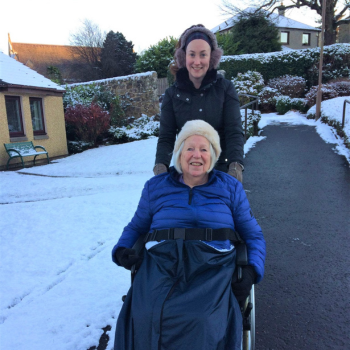Edinburgh medical students and graduates alike will be able to reflect on time in the anatomy teaching lab learning from the ‘silent teacher’ – a community member who has donated their body for the purpose of medical teaching and research. Medical School staff member, Ellie Roger, reflects on her granny’s decision to donate her body to the University of Edinburgh.
 A couple of weeks ago, I found myself sitting in the majestic McEwan Hall, surrounded by relatives of those who had donated their bodies to the University.
A couple of weeks ago, I found myself sitting in the majestic McEwan Hall, surrounded by relatives of those who had donated their bodies to the University.
For many years, my granny had spoken of her wish to donate her body to medical research. It was therefore no surprise when, following her death in January, this is what happened.
However, strangely, I had never before made the connection between this wish and the University – the place where I work. It was only after her death that it dawned on me that donating your body to ‘medical science’ meant giving your body to a university for the purposes of research and teaching.
The memorial service I was attending was the University’s way of giving thanks. It was arranged by the anatomy department and, along with other relatives, was attended by staff and students from the Medical School.
A decision about death, based on life
Granny’s decision, I think, was largely due to her own life experiences. She had been a health care professional herself, working for many years as an occupational therapist at both Perth and Dundee Royal Infirmaries.
She was also a polio survivor. In later years, she suffered with post-polio, losing much of the strength in one of her legs. In her final year, she was unable to walk more than a few steps at a time, almost confining her to a chair.
I remember her telling me that very little was known about post-polio and how, if her body was studied, maybe this would help shed some new light on the condition.
A funeral without a body
Granny’s decision also had practical implications – mainly that there was no body for a funeral.
Speaking at the service, one of the members of staff shared her own Irish heritage. She spoke of how important a body was in Ireland and how loved ones would gather round it, often with a drink in hand, as part of their final goodbyes. She recognised the sacrifice of family and friends when this was taken away.
For our family, or for me at least, this was not the case. If anything, the lack of body had made things a bit easier.
Granny was a lifelong Quaker, tracing her roots back to the founding members, and so we knew she would want a Quaker funeral. Quaker ceremonies are simple affairs, held in any meeting space. There are no ministers, hymns or set readings, instead anyone can make a contribution by sharing a memory or reading of their choice. The formal setting of a church or crematorium would have felt out of place.
Instead, our family gathered in the function room at the Grey Horse Inn in Balerno, on a day and at a time that suited us. It was a true celebration of her life, focused on happy memories, rather than the spectre of her death. Personally, I did not miss the sight of a coffin.
The ‘silent teacher’
I was very moved by a speech from the Professor of Anatomy. He described those who had given their bodies as ‘silent teachers’. Without them, medical students and anatomy professionals cannot fully unravel the mysteries of the human body. Books and lessons only go so far.
I think Granny would have liked being described in this way. In so many ways, she was a teacher her whole life. She taught my mum about plants and gardening; she taught me how to bake cakes from a family recipe passed down generations; and she taught our whole family about our Quaker roots and history.
It seems fitting that, even in death, she is continuing to teach and impart learning to others.
The personal touch
The service was beautifully conducted, dignified and personal.
I had not been involved in the bequeathment, but my auntie said this was reflective of the entire process.
One of the readings was the same poem that my auntie had chosen to share at Granny’s funeral. It had also been read at her sister’s and my Grandpa’s funeral. My auntie explained how she had mentioned the poem and its significance to Laura, the Bequest Coordinator, who had then asked her to send a copy so they could include it in the service.
After the service, we had the opportunity to speak with the staff member who had given that reading. He seemed genuinely delighted to learn where the poem had come from and told us how he intended to use it every year from now on.
This, in itself, is a lovely, lasting tribute to my wonderful grandmother.


